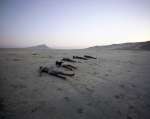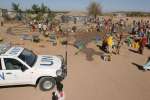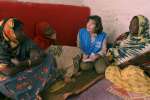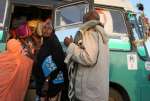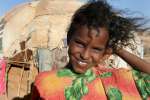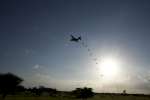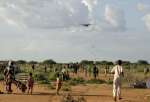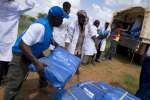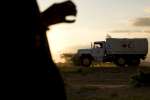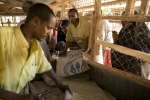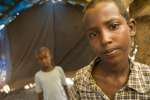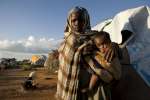UNHCR Statement on the murder of a staff member in Mogadishu, Somalia
Press Releases, 14 December 2015
It is with great sadness that UNHCR has learned of the killing of one of our colleagues, Amina Noor Mohamed, this afternoon in Mogadishu, Somalia. Amina was shot by unknown gunmen while travelling in a private vehicle driven by a staff member from a UNHCR partner organization who also lost his life in the attack.
Amina had been working as Senior Community Services Assistant with UNHCR in Mogadishu since 2011. She leaves behind her husband and two children, aged 2 years and 3 months. UNHCR's Representative in Mogadishu and other colleagues are in contact with the surviving family and are extending all possible support to them. A minute of silence will be held in Amina's memory at UNHCR Headquarters in Geneva at 11 am tomorrow.
"While the details of this senseless act of violence are still being investigated, it serves as another stark reminder of the dangers many humanitarian workers face in their daily work. On behalf of all UNHCR staff, I wish to convey our heartfelt condolences and solidarity to Amina's family, friends and to our entire team in Somalia, as well as those of our fallen NGO colleague," United Nations High Commissioner for Refugees António Guterres said.
Related Internet Links
UNHCR is not responsible for the content and availability of external internet sites
Crossing the Gulf of Aden
Every year thousands of people in the Horn of Africa - mainly Somalis and Ethiopians - leave their homes out of fear or pure despair, in search of safety or a better life. They make their way over dangerous Somali roads to Bossaso in the northern semi-autonomous region of Puntland.
In this lawless area, smuggler networks have free reign and innocent and desperate civilians pay up to US$150 to make the perilous trip across the Gulf of Aden.
Some stay weeks on end in safe houses or temporary homes in Bossaso before they can depart. A sudden call and a departure in the middle of the night, crammed in small unstable boats. At sea, anything can happen to them - they are at the whim of smugglers. Some people get beaten, stabbed, killed and thrown overboard. Others drown before arriving on the beaches of Yemen, which have become the burial ground for hundreds who many of those who died en route.
Crossing the Gulf of Aden
Somalia/Ethiopia
In February 2005, one of the last groups of Somalilander refugees to leave Aisha refugee camp in eastern Ethiopia boarded a UNHCR convoy and headed home to Harrirad in North-west Somalia - the self-declared independent state of Somaliland. Two years ago Harrirad was a tiny, sleepy village with only 67 buildings, but today more than 1,000 people live there, nearly all of whom are former refugees rebuilding their lives.
As the refugees flow back into Somalia, UNHCR plans to close Aisha camp by the middle of the year. The few remaining refugees in Aisha - who come from southern Somalia - will most likely be moved to the last eastern camp, Kebribeyah, already home to more than 10,000 refugees who cannot go home to Mogadishu and other areas in southern Somalia because of continuing lawlessness there. So far refugees have been returning to only two areas of the country - Somaliland and Puntland in the north-east.
Somalia/Ethiopia
Flood Airdrop in Kenya
Over the weekend, UNHCR with the help of the US military began an emergency airdrop of some 200 tonnes of relief supplies for thousands of refugees badly hit by massive flooding in the Dadaab refugee camps in northern Kenya.
In a spectacular sight, 16 tonnes of plastic sheeting, mosquito nets, tents and blankets, were dropped on each run from the C-130 transport plane onto a site cleared of animals and people. Refugees loaded the supplies on trucks to take to the camps.
Dadaab, a three-camp complex hosting some 160,000 refugees, mainly from Somalia, has been cut off from the world for a month by heavy rains that washed away the road connecting the remote camps to the Kenyan capital, Nairobi. Air transport is the only way to get supplies into the camps.
UNHCR has moved 7,000 refugees from Ifo camp, worst affected by the flooding, to Hagadera camp, some 20 km away. A further 7,000 refugees have been moved to higher ground at a new site, called Ifo 2.
Posted in December 2006
Flood Airdrop in Kenya


Return to Somalia
Ali and his family are ready to return to Somalia after living in Dadaab refugee camp for the past five years. We follow their journey from packing up their home in the camp to settling into their new life back in Somalia.


South Sudan: Food Security
Jacob is plowing 20 kilometers far from his own home town, Bor, after having to abandon it due to the ongoing fighting in South Sudan. Now in Mingkaman camp,as a displaced person, this land he plows is all he has after losing farm and cattle back home


Syrian Refugees: Desperate in Lampedusa
In the past year, more than 13,000 people have arrived by boat in Italy's Lampedusa Island on irregular migration routes. Many have died attempting the crossing. Young men from sub-Saharan Africa mix with families from Syria. All share the same dream - starting afresh in the security and stability of Europe.













